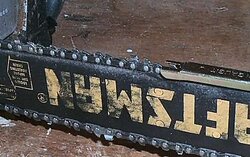I've now been through about 8 tanks of gas on my current chain (Craftsman 18"), and have been sharpening the blades regularly.
I'm now considering sharpening the depth gauges. I have the doohickey shown in the attachment. Please give me advice on how to use it for sharpening.
Thanks,
I'm now considering sharpening the depth gauges. I have the doohickey shown in the attachment. Please give me advice on how to use it for sharpening.
Thanks,


